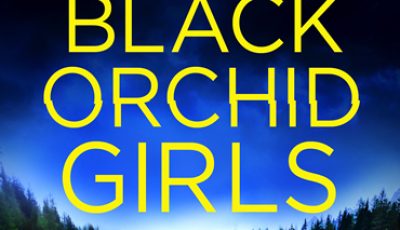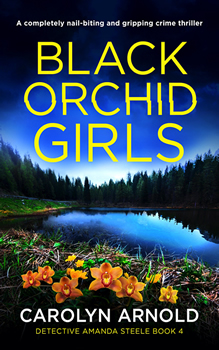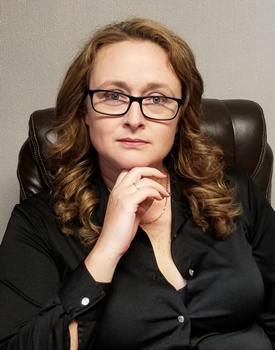

Black Orchid Girls by Carolyn Arnold
If you’re new to the work of Carolyn Arnold, a quick glance at her website will tell you what her many fans already know: When it’s fast-paced thrills you’re looking for, Arnold delivers. She’s currently juggling five popular series from the cozy McKinley Mysteries to the Indiana Jones-inspired Matthew Connor Adventures, to the hardboiled Detective Madison Knight Mysteries.
And then there’s the Detective Amanda Steele series, which kicked off with last year’s The Little Grave and continues this month with BLACK ORCHID GIRLS. In the new installment, Steele must track down a killer who’s leaving the bodies of beautiful young women in the woods, adorned with a chilling calling card: a single black orchid.
In her latest interview with The Big Thrill, Arnold offers some insight into her popular new character, gives us a look at her writing process, and offers new authors some advice about branding their work.
When it comes to a series character like Amanda Steele, how do you strike a balance between character growth and staying true to the qualities that attracted readers to her in the first place?
You’re best to start with knowing that Amanda’s world was shattered over six years ago when she lost her husband and six-year-old daughter in a car accident—a drunk driver behind the wheel. She was in the vehicle with her family at the time. While they died, she survived. In book one of the series, The Little Grave, we see an Amanda who is still reeling in grief. She’s bitter and on edge and just going through the motions in life—even when it comes to her job as a homicide detective. She’s still focused on seeing justice for murder victims, but her heart is broken. She is broken.
As the series continues, Amanda begins to heal and expand her heart. She gets a partner on the job, starts dating again…falls in love with an orphaned girl. The hard-edged detective that readers fell in love with from the start begins to thaw. Her healing process is finally in motion.
This is where Amanda’s character shows tremendous growth—first to be someone so hurt they shut everyone out, to someone who begins letting the light in. But it’s also key that with this evolution that she doesn’t lose her fighting spirit, her spark either.
What can you tell me about the inspiration for the case Amanda tackles in BLACK ORCHID GIRLS?
This book changed so much from its first conception until the end result. It took some back and forth with my editor at Bookouture, but I’m very pleased where we landed. We wanted to give Detective Amanda Steele, her partner—and readers—a unique murder case to solve. We desired to emphasize the contrast between the innocent young woman, her pale complexion, and have this starkly contrast with the black orchid that’s left on her body. But this was just the beginning of the play of good against evil, light and dark, as readers of the book will come to appreciate.
This is the fourth book in the Amanda Steele series. What are some factors you consider when you’re looking for Amanda’s next case?
It’s always looking for that unique hook that will draw in readers. There also has to be something personal and at stake for Amanda to foster character growth. The investigation itself, ideally, prompts and ignites this change in the main character. So there needs to be thought given to how this would work out most effectively.
In BLACK ORCHID GIRLS, for example, Amanda is facing the murder of female college students while she’s fostering a young girl herself. The case only deepens the love and affection she feels for the child and how lucky she is to come home to her. This encourages Amanda to open her heart even further. The healing continues.
Regardless of our educational or professional backgrounds, most of us learn to write well by reading well. When it comes to your fiction, which writers have been particularly instructive for you and why?
I read quite a lot, but at the beginning I was inspired by David Baldacci and Sandra Brown.
Baldacci has a way of painting a real picture of his characters. So real that you could pinch them. Brown shows a courageous spunk that results in her just laying it all on the page—even things that might seem brash or offensive when it came to certain characters. But that is authentic. Characters, like people, should have flaws.
Instead of a page of blurbs from fellow authors and book critics, your website features a page of testimonials from law enforcement professionals. Why are those endorsements important to you?
I offer spotlighted reviews on the individual book pages from bloggers and reviewers. As for the special endorsements page, which are testimonials from law enforcement, this it to add credit to my brand: Police Procedurals Respected by Law Enforcement.
I have the utmost respect for those in law enforcement, and I wouldn’t want to imagine a world without them. Yes, there are some bad ones, but that applies to more than the police. We wouldn’t judge other establishments based on the few, so why would we lump officers together as if they were all prejudiced and self-serving? My respect is, needless to say, for those who upload the law governed by principle and a selfless attitude to serve their communities, to make them a better and safer place to live.
Another reason I have the testimonials page from law enforcement is because it’s very important to me that I get investigative procedure right and as accurate as possible in my books.
Are there times when you have to sacrifice accuracy for the demands of plot or character? How do you make those decisions?
I’ve written nearly 40 books now, and I can’t recall ever making that concession knowingly.
You’re an impressively prolific writer. Was there ever a time when you struggled with the discipline it takes to maintain your output?
Any time it’s warm out, the sun is shining, the birds are singing, or it’s the month of December and/or it’s snowing… Of course there are times I am distracted or want to turn the computer off and run away. At the same time, I know my commitments and how long it takes me to turn the different stages of a project around.
Honestly, for the most part, I’m very motivated and anxious to get to my desk and reconnect with my characters and their worlds when I wake up. Sometimes I feel like I’m obsessed with them. With this all said, a piece of advice, which you can take or leave, is I think the secret to living a balanced life is allowing yourself the space to breathe and be. And there can be moments, even at the height of an especially stressful time—for example, a deadline is fast approaching—that stepping away can be of benefit. It can recharge the mind and body, and when you return to work, things progress and flow even better—all because you allowed yourself some downtime.
What is your plotting process like?
All over the place! I was never a plotter before working with Bookouture! But a publisher likes to know what they’re signing on for, so a synopsis with an overview of the plot is necessary. And with persistence and tenacity, I think I have the synopsis thing down. (Almost afraid to say that out loud in case it jinxes me.) My synopses, though, are certainly not detailed outlines. I’ve heard of authors writing a book outline the length of a novel before starting to write the actual book. Not me! My synopses are anywhere from six to twelve pages in length. As a previous pantser, I find raising questions and running through the answers goes a long way into planning a plot. I also do my best to sort of detach, to see the story from an eagle-eye viewpoint. But there are times my characters crawl into my head and demand that I write and insert brief exchanges of dialogue! We authors think we control our characters, but I think there’s give and take…
You don’t just write a lot of books; you write a lot of books that keep readers happy. With such a grueling release schedule, what are some work habits you’ve developed to make sure the quality of your work stays high?
I do my best to stay inspired and in love with my work in progress. That then hits the page. As for work habits, I would never have even a sip of alcohol during the writing or editing process. I view my time at my desk as sacred and respect the craft and my work. I do my best to exercise at least a couple times a week too—more if I can swing it—and find that clears my mind too.
Going back to branding, The Big Thrill is as much for writers as it is for readers. What advice do you have for new authors about building their brand, regardless of their genre or category?
Know your genre. This covers everything from branding—cover design, website layouts, how successful authors in the genre handle their social media—to the tropes involved. Before writers put fingers to keyboard, I recommend becoming very familiar with all of this. It will go a long way in the success of your book. Craft your story to fit into the categories you want to target. All this is not to say you have to be unoriginal, but readers have come to expect certain things from each genre out there. Know what that is and include it, whether it’s character traits, settings, or mechanisms—such as the main protagonist finding themselves in danger or red herrings in crime fiction and mysteries.
What’s next for you?
Lots of writing and editing. As I prepare this interview, I’m working on book five for Detective Amanda Steele, and I have two other projects in the wings. One of these is the rewriting, rebranding, and marketing of a cozy series.
*****
Carolyn Arnold is an international bestselling and award-winning author, as well as a speaker, teacher, and inspirational mentor. She has several continuing fiction series and has many published books. Her genre diversity offers her readers everything from cozy to hard-boiled mysteries, and thrillers to action adventures. Her crime fiction series have been praised by those in law enforcement as being accurate and entertaining. This led to her adopting the trademark: POLICE PROCEDURALS RESPECTED BY LAW ENFORCEMENT™.
Carolyn was born in a small town and enjoys spending time outdoors, but she also loves the lights of a big city. Grounded by her roots and lifted by her dreams, her overactive imagination insists that she tell her stories. Her intention is to touch the hearts of millions with her books, to entertain, inspire, and empower.
She currently lives near London, Ontario, Canada with her husband and two beagles.
To learn more about the author and her work, please visit her website.
- Between the Lines: Rita Mae Brown - March 31, 2023
- Between the Lines: Stephen Graham Jones - January 31, 2023
- Between the Lines: Grady Hendrix - December 30, 2022


